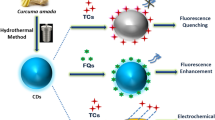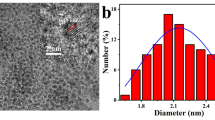Abstract
Being a persuasive antibiotic, ciprofloxacin is widely administered to patients and its excessive discharge has generated a keen interest among researchers for its detection in water resources. Therefore, the current work utilizes the virtues of carbon dots synthesized from the leaves of Ocimum sanctum as an economical and convenient bimodal stratagem for the detection of ciprofloxacin via an electrochemical and fluorometric approach. The insight into photostability, size, morphology, and optical studies of the carbon dots was tested to enhance their scope in sensing. The excellent photoluminescence-based excitation-dependent behavior with a quantum yield of 46.7% and non-requirement of any kind of labeled surface variations for amending their fluorescence and electrochemical properties have further supported the utilization of as-prepared carbon dots in trace-level monitoring of ciprofloxacin. The fluorescence emission intensity and peak current were enhanced by many folds via the application of Ocimum sanctum–derived carbon dots. The synergetic effect of carbon dots has possessed a linear relationship between the peak current/emission intensity within the range of 0 to 250 μM of ciprofloxacin and the lowest detection limit value was found to be 0.293 and 0.0822 μM with fluorometric and electrochemical methods, respectively. The sensor demonstrated excellent applicability for the estimation of ciprofloxacin and acts as a high-performance dual sensor for further applications.
Graphical Abstract








Similar content being viewed by others
References
Shan L, Ming G, Xiaohua P, Wenjie L, Jingjie W, Huaxin L, Hua T (2022) Association between fluoroquinolone exposure and children's growth and development: a multisite biomonitoring-based study in northern China. Environ Res 214:113924. https://doi.org/10.1016/j.envres.2022.113924
Nakase K, Yui S, Hidemasa N, Norihisa N (2016) Emergence of fluoroquinolone-resistant Propionibacterium acnes caused by amino acid substitutions of DNA gyrase but not DNA topoisomerase IV. Anaerobe 42:166–171. https://doi.org/10.1016/j.anaerobe.2016.10.012
Piccinelli G, Gargiulo F, Biscaro V, Caccuri F, Caruso A, Francesco MAD (2017) Analysis of mutations in DNA gyrase and topoisomerase IV of Ureaplasma urealyticum and Ureaplasma parvum serovars resistant to fluoroquinolones. Infect Genet and Evol 47:64–67. https://doi.org/10.1016/j.meegid.2016.11.019
Sodhi KK, Singh DK (2021) Insight into the fluoroquinolone resistance, sources, ecotoxicity, and degradation with special emphasis on ciprofloxacin. J Water Process Eng 43:102218. https://doi.org/10.1016/j.jwpe.2021.102218
Darabi Z, Niakan M, Khaledi M, Afkhami H, Soltanimoghadam F (2022) The investigation of P1 gene in Mycoplasma pneumonia isolated from atypic pneumonia by molecular methods, determine IgG antibody and MIC to ciprofloxacin antibiotic. New Microbe New Infect 46:100954. https://doi.org/10.1016/j.nmni.2022.100954
Yang P, Luo J, Wang Z, Zhang L, Xie X, Shi Q, Zhang X (2022) Synthesis and in vitro antibacterial activity of N-acylarylhydrazone-ciprofloxacin hybrids as novel fluoroquinolone derivatives. J Mol Struct 1262:133007. https://doi.org/10.1016/j.molstruc.2022.133007
Hasan MDR, Chowdhury SM, Aziz MA, Shahriar A, Ahmed H, Khan MA, Mahmud S, Emran TB (2021) In silico analysis of ciprofloxacin analogs as inhibitors of DNA gyrase of Staphylococcus aureus. Informat Med Unlocked 26:100748. https://doi.org/10.1016/j.imu.2021.100748
Shi C, Ignjatović J, Wang J, Guo Y, Zhang L, Cvijić S, Cun D, Yang M (2022) Evaluating the pharmacokinetics of intrapulmonary administered ciprofloxacin solution for respiratory infections using in vivo and in silico PBPK rat model studies. Chin Chem Lett. https://doi.org/10.1016/j.cclet.2022.04.061
Bhagat C, Kumar M, Tyagi VK et al (2020) Proclivities for prevalence and treatment of antibiotics in the ambient water: a review. NPJ Clean Water 3:42. https://doi.org/10.1038/s41545-020-00087-x
Souza CCD, Cunha C, Alves GF, Lisboa TP, Matos MAC, Matos RC (2022) Low-cost paper-based electrochemical sensor for the detection of ciprofloxacin in honey and milk samples. J Food Compos Anal 112:104700. https://doi.org/10.1016/j.jfca.2022.104700
Huang QD, Lv CH, Yuan XL, He M, Lai JP, Sun H (2021) A novel fluorescent optical fiber sensor for highly selective detection of antibiotic ciprofloxacin based on replaceable molecularly imprinted nanoparticles composite hydrogel detector. Sens Actuators B- Chem 328:129000. https://doi.org/10.1016/j.snb.2020.129000
Yu F, Bai X, Liang M, Ma J (2022) HKUST-1-Derived Cu@ Cu (I)@ Cu (II)/Carbon adsorbents for ciprofloxacin removal with high adsorption performance. Sep Purif Technol 288:120647. https://doi.org/10.1016/j.seppur.2022.120647
Cuprys A, Thomson P, Ouarda Y, Suresh G, Rouissi T, Brar SK, Drogui P, Surampalli RY (2020) Ciprofloxacin removal via sequential electro-oxidation and enzymatic oxidation. J Hazard Mater 389:121890. https://doi.org/10.1016/j.jhazmat.2019.121890
Haleem FMA, Rizk MS, Badr IHA (2017) Potentiometric determination of ciprofloxacin in physiological fluids using carbon paste and nano-composite carbon paste electrodes. Electroanalysis 29:1172-1179. https://doi.org/10.1002/elan.201600735
Fu B, Zheng X, Li H, Ding L, Wang F, Guo D, Yang W, Pan Q (2021) A highly stable, rapid and sensitive fluorescent probe for ciprofloxacin based on Al3+-enhanced fluorescence of gold nanoclusters. Sens Actuators B-Chem 346:130502. https://doi.org/10.1016/j.snb.2021.130502
Liu X, Wang T, Lu Y, Wang W, Zhou Z, Yan Y (2019) Constructing carbon dots and CdTe quantum dots multi-functional composites for ultrasensitive sensing and rapid degrading ciprofloxacin. Sens Actuators B- Chem 289:242–251. https://doi.org/10.1016/j.snb.2019.03.094
Garbellini G, Rocha-Filho R, Fatibello-Filho O (2015) Voltammetric determination of ciprofloxacin in urine samples and its interaction with dsDNA on a cathodically pretreated boron-doped diamond electrode. Anal Methods 7:3411–3418. https://doi.org/10.1039/C5AY00625B
Wang B, Yan B (2020) A turn-on fluorescence probe Eu3+ functionalized Ga-MOF integrated with logic gate operation for detecting ppm-level ciprofloxacin (CIP) in urine. Talanta 208:120438. https://doi.org/10.1016/j.talanta.2019.120438
Munir F, Waseem MT, Khan ZA, Majeed S, Farooq U, Shahzad SA (2022) Synthesis of AIEE active triazine based new fluorescent and colorimetric probes: a reversible mechanochromism and sequential detection of picric acid and ciprofloxacin. J Photochem Photobiol 429:113921. https://doi.org/10.1016/j.jphotochem.2022.113921
Kaur H, Siwal SS, Chauhan G, Saini AK, Kumari A, Thakur VK (2022) Recent advances in electrochemical-based sensors amplified with carbon-based nanomaterials (CNMs) for sensing pharmaceutical and food pollutants. Chemosphere:135182. https://doi.org/10.1016/j.chemosphere.2022.135182
Singhal A, Sadique MA, Kumar N, Yadav S, Ranjan P, Parihar A, Khan R, Kaushik AK (2022) Multifunctional carbon nanomaterials decorated molecularly imprinted hybrid polymers for efficient electrochemical antibiotics sensing. J Environ Chem Eng:107703. https://doi.org/10.1016/j.jece.2022.107703
Yuan X, Lv W, Wang B, Yan C, Ma Q, Zheng B, Du J, Xiao D (2021) Silicon nanoparticles-based ratiometric fluorescence platform: real-time visual sensing to ciprofloxacin and Cu2+. Spectrochim Acta A: Mol Biomol Spectrosc 253:119599. https://doi.org/10.1016/j.saa.2021.119599
Manea Y, Kadaf Y, Khan AM, Wani AA, Qashqoosh MTA, Shahadat M, Salem MAS (2021) Hydrothermally synthesized mesoporous CS-g-PA@ TSM functional nanocomposite for efficient photocatalytic degradation of ciprofloxacin and treatment of metal ions. J Mol Liq 335:116144. https://doi.org/10.1016/j.molliq.2021.116144
Lv H, Yuan Y, Xu Q, H.i Liu, Y. Wang, and Y. Xia. (2018) Carbon quantum dots anchoring MnO2/graphene aerogel exhibits excellent performance as electrode materials for supercapacitor. J Power Sources 398:167–174. https://doi.org/10.1016/j.jpowsour.2018.07.059
Zhang H, Huang K, Ding L, Yang J, Yang Y, Liang F (2022) Electrochemical determination of paraquat using a glassy carbon electrode decorated with pillararene-coated nitrogen-doped carbon dots. Chin Chem Lett 33:1537–1540. https://doi.org/10.1016/j.cclet.2021.09.002
Saberi Z, Rezaei B, Ensafi AA (2019) Fluorometric label-free aptasensor for detection of the pesticide acetamiprid by using cationic carbon dots prepared with cetrimonium bromide. Microchimica Acta 186:1–7. https://doi.org/10.1007/s00604-019-3378-9
Chaudhary S, Kumari M, Chauhan P, Chaudhary GR (2021) Upcycling of plastic waste into fluorescent carbon dots: an environmentally viable transformation to biocompatible C-dots with potential prospective in analytical applications. Waste Manag 120:675–686. https://doi.org/10.1016/j.wasman.2020.10.038
Kumari R, Sahu SK (2022) A new insight into multicolor emissive carbon dots using Trachelospermum jasminoides leaves for the application of WLEDs. Colloid Surf A 647:128959. https://doi.org/10.1016/j.colsurfa.2022.128959
Chellasamy G, Arumugasamy SK, Govindaraju S, Yun K (2022) Green synthesized carbon quantum dots from maple tree leaves for biosensing of Cesium and electrocatalytic oxidation of glycerol. Chemosphere 287:131915. https://doi.org/10.1016/j.chemosphere.2021.131915
Chauhan P, Chaudhary S, Bhasin KK (2021) Usage of agarose gel waste for the high yield production of carbon dots and new insight into their toxicological screening. Process Biochem 102:229–239. https://doi.org/10.1016/j.procbio.2021.01.015
Vijeata A, Chaudhary GR, Chaudhary S, Umar A, Baskoutas S (2022) Carbon Dots derived from Ocimum sanctum for dapsone–protein interactions: a quantitative approach. J Nanostruct Chem 13:1–9. https://doi.org/10.1007/s40097-022-00503-3
Li Y, Li S, Wang Y, Wang J, Liu H, Liu X, Wang L, Liu X, Xue W, Ma N (2017) Electrochemical synthesis of phosphorus-doped graphene quantum dots for free radical scavenging. Phys Chem Chem Phys 19:11631–11638. https://doi.org/10.1039/C6CP06377B
Kang J, Kang D (2021) Effect of amino acid-derived nitrogen and/or sulfur doping on the visible-light-driven antimicrobial activity of carbon quantum dots: a comparative study. Chem Eng J 420:129990. https://doi.org/10.1016/j.cej.2021.129990
Khaliq T, Waseem MA, Lone AM, Hassan QP (2018) Oscimum sanctum extract inhibits growth of Gram positive and Gram negative bacterial strains. Microbial Pathogenesis 118:211–213. https://doi.org/10.1016/j.micpath.2018.03.040
Kalanidhi K, Nagaraaj P (2021) Facile and Green synthesis of fluorescent N-doped carbon dots from betel leaves for sensitive detection of picric acid and iron ion. J Photochem Photobiol 418:113369. https://doi.org/10.1016/j.jphotochem.2021.113369
Zygouri P, Spyrou K, Mitsari E, Barrio M, Macovez R, Patila M, Stamatis H (2020) A facile approach to hydrophilic oxidized fullerenes and their derivatives as cytotoxic agents and supports for nanobiocatalytic systems. Sci. rep. 10:1–13. https://doi.org/10.1038/s41598-020-65117-7
Liang Y, Yang H, Zhou B, Chen Y, Yang M, Wei K, Yan X, Kang C (2022) Waste tobacco leaves derived carbon dots for tetracycline detection: improving quantitative accuracy with the aid of chemometric model. Anal Chim Acta 1191:339269. https://doi.org/10.1016/j.aca.2021.339269
K kanthi Gudimella, Gedda G, Senthil Kumar P, Babu BK, Yamajala B, Rao BV, Singh PP, Kumar D, Sharma A (2022) Novel synthesis of fluorescent carbon dots from bio-based Carica papaya leaves: optical and structural properties with antioxidant and anti-inflammatory activities. Environ Res 204:111854. https://doi.org/10.1016/j.envres.2021.111854
Wen F, Li P, Meng H, Yan H, Huang X, Hao C, Su W (2022) Nitrogen-doped carbon dots/curcumin nanocomposite for combined Photodynamic/photothermal dual-mode antibacterial therapy. Photodiag Photodyn Ther:103033. https://doi.org/10.1016/j.pdpdt.2022.103033
Chaabani A, Jabrallah T, Belhadj N, Tahar (2022) Electrochemical oxidation of ciprofloxacin on COOH-functionalized multi-walled carbon nanotube–coated vitreous carbon electrode. Electrocatalysis 13:402–413. https://doi.org/10.1007/s12678-022-00725-7
Shen B, Wen X, Korshin GV (2018) Electrochemical oxidation of ciprofloxacin in two different processes: the electron transfer process on the anode surface and the indirect oxidation process in bulk solutions. Environ Sci Process Impacts 20:943–955. https://doi.org/10.1039/C8EM00122G
Wang Y, Sun X, Cai L, Wang H, Zhang B, Fang G, Wang S (2022) A “signal on/off” biomimetic electrochemiluminescence sensor using titanium carbide nanodots as co-reaction accelerator for ultra-sensitive detection of ciprofloxacin. Anal Chim Acta 1206:339690. https://doi.org/10.1016/j.aca.2022.339690
Acknowledgements
The authors are thankful to the Deanship of Scientific Research and the supervision of the Centre for Scientific and Engineering Research at Najran University, Najran, Kingdom of Saudi Arabia, for funding under the Research Centers funding program Grant No. NU/RCP/SERC/12/3. Anjali Vijeata is thankful to Council of Scientific and Industrial Research (CSIR), New Delhi, for financial support under CSIR (09/135(0894)/2019-EMR-l). Savita Chaudhary is thankful to DST Inspire Faculty award [IFACH-17], Haryana State Council for Science and Technology [HSCSIT/R&D/2020/476], and DST Chandigarh and DST Purse grants II for financial assistance. Ganga Ram Chaudhary would like to acknowledge the support of UGC, India, under the INDO-US 21st Century knowledge Initiative project [F.No. 194-2/2016 (IC)]. The authors are thankful to the Sophisticated Analytical Instrumentation Facility (SAIF, CIL), Panjab University, Chandigarh, for the technical support.
Author contribution
Anjali Vijeata: conceptualization, methodology, software, validation, formal analysis, investigation, data curation, writing—original draft.
Savita Chaudhary: conceptualization; methodology; validation; formal analysis; resources ; writing—review and editing; visualization ; supervision ; project administration; funding acquisition.
Ahmad Umar: methodology; visualization; writing—original draft; writing—review and editing; formal analysis; resources.
Ganga Ram Chaudhary, Sheikh Akbar, Sotirios Baskoutas: methodology; visualization ; writing—review and editing; formal analysis; resources.
Author information
Authors and Affiliations
Corresponding authors
Ethics declarations
Conflict of interest
The authors declare no competing interests.
Additional information
Publisher’s note
Springer Nature remains neutral with regard to jurisdictional claims in published maps and institutional affiliations.
Supplementary information
ESM 1
Supplementary data to this file can be found online.
Rights and permissions
Springer Nature or its licensor (e.g. a society or other partner) holds exclusive rights to this article under a publishing agreement with the author(s) or other rightsholder(s); author self-archiving of the accepted manuscript version of this article is solely governed by the terms of such publishing agreement and applicable law.
About this article
Cite this article
Vijeata, A., Chaudhary, G.R., Chaudhary, S. et al. Label free dual-mode sensing platform for trace level monitoring of ciprofloxacin using bio-derived carbon dots and evaluation of its antioxidant and antimicrobial potential. Microchim Acta 190, 258 (2023). https://doi.org/10.1007/s00604-023-05830-y
Received:
Accepted:
Published:
DOI: https://doi.org/10.1007/s00604-023-05830-y




